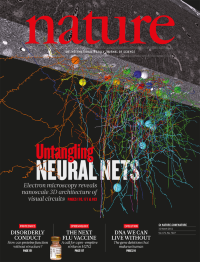Volume 471
-
No. 7340 31 March 2011
The early history of flowering plants (angiosperms) is contentious, but a steady stream of fossil discoveries from the Early Cretaceous of China is beginning to fill in some of the gaps in our knowledge. The latest of these, found in the Lower Cretaceous Yixian Formation, is a fossil that dates to between 124.4 million and 122.9 million years old. It is particularly informative because this angiosperm is a eudicot - the relatively derived group that dominates the flowering plants in the world today - and is also possibly a member of the Ranunculaceae. The fossil (pictured) confirms the presence of the eudicots at this time and documents an early burst of angiosperm evolution.
-
No. 7339 24 March 2011
Transgenic zebrafish carrying the human oncogene BRAF(V600E), the most common mutation in melanoma patients, provide a convenient model for melanoma. Two papers from Leonard Zon and colleagues demonstrate the potential of this system in the study of cancer genetics and in drug development. Ceol et al. screen for genes that cooperate with mutated BRAF, and identify SETDB1 as capable of accelerating melanoma formation in fish. The gene is found in a region that is frequently amplified in human melanomas, and its gene product, SETDB1, is a histone methylating enzyme that is often overexpressed in those melanomas. This work establishes SETDB1 as an important oncogene. White et al. find expression of a gene signature in melanoma-susceptible zebrafish embryos that is indicative of disrupted differentiation of neural crest progenitors. A chemical screen identifies leflunomide, an immunomodulatory drug used to treat rheumatoid arthritis, as an inhibitor of neural crest stem cells. Leflunomide has antimelanoma activity in human melanoma xenografts and might prove useful as an anticancer drug, particularly in combination with BRAF inhibitors. On the cover, a heavily pigmented zebrafish expressing both SETDB1 and BRAF-V600E in its melanocytes. Credit: Yariv Houvras.
Nature Outlook
-
No. 7338 17 March 2011
The female steroid hormone progesterone is produced by the ovaries and the placenta, and supports gestation and embryogenesis through its actions on a well-characterized nuclear progesterone receptor. But progesterone released by cells surrounding the egg also stimulates sperm cells within the Fallopian tubes and increases their fertilizing ability, and the mechanism of this action of progesterone has remained elusive. Two independent research groups now report that progesterone potently activates CatSper, the principal Ca2+ channel of the sperm flagellum. Their data demonstrate that the CatSper channel or a directly associated membrane protein serves as a novel progesterone receptor that can mediate a fast, non-genomic effect of progesterone at the level of the sperm plasma membrane. These results should help to define the physiological role of progesterone and CatSper in sperm, and could lead to the development of new classes of non-hormonal contraceptives. Illustration by Ren Pascal/Center of Advanced European Study and Research, Bonn, Germany.
-
No. 7337 10 March 2011
Connectivity forms the basis of functional computations performed by neural circuits, but it is notoriously difficult to follow the complex structural wiring between neurons to the function of individual cells. Now, using a combination of functional imaging and three-dimensional serial electron-microscopic reconstruction at an unprecedented scale, two groups present detailed representations of the connectivity of single cells in the mouse visual system. Davi Bock et al. in Clay Reids lab investigate connectivity in the primary visual cortex, and find that inhibitory neurons receive input from excitatory cells with widely varying functions (represented on the cover by spheres and lines of different colours), consistent with predictions from recent physiological studies of the mouse cortex. Kevin Briggman, Moritz Helmstaedter and Winfried Denk show that direction-selective ganglion cells receive more synapses from a starburst amacrine cell dendrite if their preferred directions are opposites, suggesting that the directional sensitivity of retinal ganglion cells arises from the asymmetry in their wiring with amacrine cells.
-
No. 7336 3 March 2011
In 1946, a study began of all the babies born in one March week in England, Wales and Scotland, with a view to learning more about the social and economic costs of childbearing. Today the study is still going, and is one of the longest-running studies of human development in the world. The 1946 cohort has been followed into adulthood, so has allowed researchers to investigate how childhood health and lifetime social circumstances affect adult health and wealth. This week, the participants celebrate their 65th birthdays, the age at which many people in the United Kingdom retire. So now the National Survey of Health and Development has become a study of ageing. Helen Pearson talked to the surveys scientists and members of the 1946 cohort about the scientific immortality that their participation has given them, and looks at how priceless the accumulated data have become. Cover graphic: Oliver Munday.





